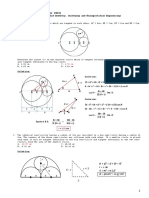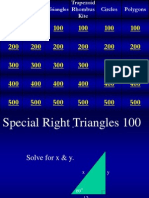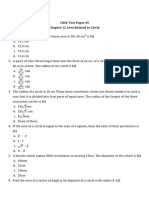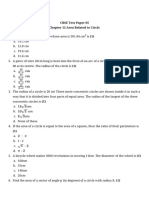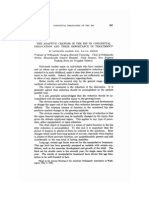BEM 6th Ed Sol To Exerc Chap 26 2013
BEM 6th Ed Sol To Exerc Chap 26 2013
Uploaded by
Josh AmuraoCopyright:
Available Formats
BEM 6th Ed Sol To Exerc Chap 26 2013
BEM 6th Ed Sol To Exerc Chap 26 2013
Uploaded by
Josh AmuraoOriginal Title
Copyright
Available Formats
Share this document
Did you find this document useful?
Is this content inappropriate?
Copyright:
Available Formats
BEM 6th Ed Sol To Exerc Chap 26 2013
BEM 6th Ed Sol To Exerc Chap 26 2013
Uploaded by
Josh AmuraoCopyright:
Available Formats
CHAPTER 26 THE CIRCLE AND ITS PROPERTIES
EXERCISE 101 Page 263
1. Calculate the length of the circumference of a circle of radius 7.2 cm
Circumference, c = 2r = 2(7.2) = 45.24 cm
2. If the diameter of a circle is 82.6 mm, calculate the circumference of the circle
Circumference, c = 2r = d = (82.6) = 259.5 mm
3. Determine the radius of a circle whose circumference is 16.52 cm
c 16.52
Circumference, c = 2πr from which, radius, r = 2 2 = 2.629 cm
4. Find the diameter of a circle whose perimeter is 149.8 cm
If perimeter, or circumference, c = d,
then 149.8 = d
149.8
and diameter, d = = 47.68 cm
5. A crank mechanism is shown below, where XY is a tangent to the circle at point X. If the
circle radius 0X is 10 cm and length 0Y is 40 cm, determine the length of the connecting rod
XY.
If XY is a tangent to the circle, then 0XY = 90
© John Bird Published by Taylor & Francis 422
Thus, by Pythagoras, 0Y 2 0X 2 XY 2
from which, XY =
0Y 2
0X 2 402 10 2 1500
= 38.73 cm
6. If the circumference of the earth is 40 000 km at the equator, calculate its diameter.
c 40000
Circumference, c = 2r = d from which, diameter, d = = 12732 km = 12730 km,
correct to 4 significant figures.
7. Calculate the length of wire in the paper clip shown below. The dimensions are in millimetres.
1 1
2 2.5 2 2.5
Length of wire = (12 – 2.5) + 2 + (32 – 2.5 – 6 – 2.5) + 2 + (32 – 2.5 – 3)
1
2 3
+ 2 + 3 + 12
= 9.5 + 2.5 + 21 + 2.5 + 26.5 + 3 + 3 + 12
= 72 + 8
= 97.13 mm
© John Bird Published by Taylor & Francis 423
EXERCISE 102 Page 264
1. Convert to radians in terms of : (a) 30 (b) 75 (c) 225
30
(a) 30 = 180 rad = 6 rad
5
75
(b) 75 = 180 rad = 12 rad
45 15 5
225 rad rad
(c) 225 = 180 rad = 36 12 = 4 rad
2. Convert to radians, correct to 3 decimal places: (a) 48 (b) 8451' (c) 23215'
48
(a) 48 = 180 rad = 0.838 rad
51
84 84.85
(b) 8451 = 60 180 180 rad = 1.481 rad
232.25
(c) 23215 = 180 rad = 4.054 rad
7 4 7
3. Convert to degrees: (a) 6 rad (b) 9 rad (c) 12 rad
7 7 180
rad
(a) 6 = 6 = 7 × 30 = 210
4 4 180
rad
(b) 9 = 9 = 4 × 20 = 80
7 7 180
rad
(c) 12 = 12 = 7 × 15 = 105
4. Convert to degrees and minutes: (a) 0.0125 rad (b) 2.69 rad (c) 7.241 rad
© John Bird Published by Taylor & Francis 424
180
0.0125
(a) 0.0125 rad = = 0.716 or 043
180
2.69
(b) 2.69 rad = = 154.126 or 1548
180
7.241
(c) 7.241 rad = = 414.879 or 41453
5. A car engine speed is 1000 rev/min. Convert this speed into rad/s.
1000 rev / min 2 rad / rev
1000 rev/min = 60s / min = 104.7 rad/s
© John Bird Published by Taylor & Francis 425
EXERCISE 103 Page 266
1. Calculate the area of a circle of radius 6.0 cm, correct to the nearest square centimetre.
r 2 6.0
2
2
Area of circle = = 113 cm
2. The diameter of a circle is 55.0 mm. Determine its area, correct to the nearest square millimetre.
d2 55.02
r 2
4 4 = 2376 mm 2
Area of circle =
3. The perimeter of a circle is 150 mm. Find its area, correct to the nearest square millimetre.
150 75
Perimeter = circumference = 150 = 2πr from which, radius, r = 2
2
75
r 2
Area of circle = = 1790 mm 2
4. Find the area of the sector, correct to the nearest square millimetre, of a circle having a radius of
35 mm, with angle subtended at centre of 75.
75
r 2 352 2
Area of sector = 360 360 = 802 mm
5. An annulus has an outside diameter of 49.0 mm and an inside diameter of 15.0 mm. Find its
area correct to 4 significant figures.
d12 d2
r12 r2 2 2 d12 d 2 2 49.0 2 15.02 2
Area of annulus = 4 4 4 4 = 1709 mm
© John Bird Published by Taylor & Francis 426
6. Find the area, correct to the nearest square metre, of a 2 m wide path surrounding a circular plot
of land 200 m in diameter.
2
d1 d 2 2 2042 2002 2
Area of path = 4 4 = 1269 m
7. A rectangular park measures 50 m by 40 m. A 3 m flower bed is made round the two longer
sides and one short side. A circular fish pond of diameter 8.0 m is constructed in the centre of
the park. It is planned to grass the remaining area. Find, correct to the nearest square metre, the
area of grass.
8.02
Area of grass = (50 40) – 2(50 3) – (34 3) - 4 = 2000 – 300 – 102 - 16 = 1548 m 2
8. With reference to the diagram, determine (a) the perimeter, and (b) the area.
1
(a) Perimeter = 17 + 28 + 17 + 2 (2π × 14) = 106.0 cm
1
142 2
(b) Area = (28 × 17) + 2 = 476 + 98π = 783.9 cm
9. Find the area of the shaded portion shown.
© John Bird Published by Taylor & Francis 427
2 2
Shaded area = (10 × 10) - π(5) = 100 - 25π = 21.46 m
10. Find the length of an arc of a circle of radius 8.32 cm when the angle subtended at the centre is
2.14 radians. Calculate also the area of the minor sector formed.
Arc length, s = r = (8.32)(2.14) = 17.80 cm
1 2 1
r 8.32 2.14
2
2
Area of minor sector = 2 2 = 74.07 m
11. If the angle subtended at the centre of a circle of diameter 82 mm is 1.46 rad, find the lengths of
the (a) minor arc, and (b) major arc.
82
If diameter d = 82 mm, radius r = 2 = 41 mm
(a) Minor arc length, s = r = (41)(1.46) = 59.86 mm
(b) Major arc length = circumference – minor arc
= 2(41) – 59.86 = 257.61 – 59.86 = 197.8 mm
12. A pendulum of length 1.5 m swings through an angle of 10 in a single swing. Find, in
centimetres, the length of the arc traced by the pendulum bob.
10
Arc length of pendulum bob, s = r = (1.5) 180 = 0.262 m or 26.2 cm
13. Determine the shaded area of the section shown.
© John Bird Published by Taylor & Francis 428
1
2 2 2
Shaded area = (12 × 15) + 2 [ π(8) ] - π(5) = 180 + 32π - 25π = 180 + 7π = 202 mm
14. Determine the length of the radius and circumference of a circle if an arc length of 32.6 cm
subtends an angle of 3.76 radians.
s 32.6
Arc length, s = r from which, radius, r = 3.76 = 8.67 cm
Circumference = 2πr = 2π(8.67) = 54.48 cm
15. Determine the angle of lap, in degrees and minutes, if 180 mm of a belt drive are in contact with a
pulley of diameter 250 mm.
250
Arc length, s = 180 mm, radius, r = 2 = 125 mm
s 180 180
1.44
Since s = r, the angle of lap, = r 125 = 1.44 rad = = 82.5
16. Determine the number of complete revolutions a motorcycle wheel will make in travelling 2 km,
if the wheel's diameter is 85.1 cm.
If wheel diameter = 85.1 cm, then circumference, c = d = (85.1) cm = 267.35 cm = 2.6735 m
2000
Hence, number of revolutions of wheel in travelling 2000 m = 2.6735 = 748.08
© John Bird Published by Taylor & Francis 429
Thus, number of complete revolutions = 748
17. The floodlights at a sports ground spread its illumination over an angle of 40 to a distance of
48 m. Determine (a) the angle in radians, and (b) the maximum area that is floodlit.
40 rad
(a) In radians, 40 = 180 = 0.69813 rad = 0.698 rad, correct to 3 decimal places
1 2 1
r 48 0.69813
2
2
(b) Maximum area floodlit = area of sector = 2 2 = 804.2 m
18. Find the area swept out in 50 minutes by the minute hand of a large floral clock, if the
hand is 2 m long.
50 50
r 2 2
2
2
Area swept out = 60 60 = 10.47 m
19. Determine (a) the shaded area below, (b) the percentage of the whole sector that the area of the
shaded area represents.
1 1 1
(50) 2 (0.75) (38) 2 (0.75) (0.75) 502 382 2
(a) Shaded area = 2 2 = 2 = 396 mm
396
100%
1
(50) 2 (0.75)
(b) Percentage of whole sector = 2 = 42.24%
20. Determine the length of steel strip required to make the clip shown.
© John Bird Published by Taylor & Francis 430
230
Angle of sector = 360 - 130 = 230 = 180 rad = 4.01426 rad
Thus, arc length, s = r = (125)(4.01426) = 501.783 mm
Length of steel strip in clip = 100 + 501.783 + 100 = 701.8 mm
21. A 50 tapered hole is checked with a 40 mm diameter ball as shown below. Determine the length
shown as x.
35 35
From the sketch below, tan 25 = AC from which, AC = tan 25 = 75.06 mm
20 20
and sin 25 = AB from which, AB = sin 25 = 47.32 mm
© John Bird Published by Taylor & Francis 431
i.e. AC = 75.06 = x + 20 + AB
= x + 20 + 47.32
and x = 75.06 – 20 – 47.32
i.e. x = 7.74 mm
EXERCISE 104 Page 269
1. Determine (a) the radius, and (b) the co-ordinates of the centre of the circle given by the equation:
2 2
x + y - 6x + 8y + 21 = 0
Method 1: The general equation of a circle (x a) (y b) r is x y 2ex 2fy c 0
2 2 2 2 2
2e 2f
where co-ordinate, a = - 2 , co-ordinate, b = - 2 and radius, r = a 2 b2 c
2e 6 2f 8
Hence, if x y 6x 8y 21 0 then a = - 2
2 2
2 = 3, b = - 2 2 =-4
(3) 2 (4) 2 (21) (9 16 21) 4
and radius, r = =2
i.e. the circle x y 6x 8y 21 0 has
2 2
(a) radius 2, and (b) centre at (3, - 4), as shown below.
© John Bird Published by Taylor & Francis 432
Method 2: x y 6x 8y 21 0 may be rearranged as: (x 3) (y 4) 4 0
2 2 2 2
i.e. (x 3) (y 4) 2 which has a radius of 2 and centre at (3, - 4)
2 2 2
2 2
2. Sketch the circle given by the equation: x + y - 6x + 4y - 3 = 0
Method 1: The general equation of a circle (x a) (y b) r is x y 2ex 2fy c 0
2 2 2 2 2
2e 2f
where co-ordinate, a = - 2 , co-ordinate, b = - 2 and radius, r = a 2 b2 c
2e 6 2f 4
Hence, if x y 6x 4y 3 0 then a = - 2
2 2
2 = 3, b = - 2 2 =-2
(3) 2 (2) 2 ( 3) (9 4 3) 16
and radius, r = =4
i.e. the circle x y 6x 4y 3 0 has centre at (3, - 2) and radius 4, as shown
2 2
below.
Method 2: x y 6x 4y 3 0 may be rearranged as: (x 3) (y 2) 16 0
2 2 2 2
i.e. (x 3) (y 2) 4 which has a radius of 4 and centre at (3, - 2)
2 2 2
© John Bird Published by Taylor & Francis 433
2 2
3. Sketch the curve: x + (y - 1) - 25 = 0
2 2 2 2
x + (y - 1) - 25 = 0 i.e. x + (y - 1) = 25
2 2 2
i.e. x + (y - 1) = 5
which represents a circle, centre (0, 1) and radius 5 as shown in the sketch below.
y 2
1
4. Sketch the curve: x = 6 6
y 2 x y 2 2 2
x 6 1 1 x y
1
If 6 then
6 6 and 6 6
x 2 y2
1
i.e. 62 62 and x 2 y 2 62
which is a circle of radius 6 and co-ordinates of centre at (0, 0), as shown below.
© John Bird Published by Taylor & Francis 434
© John Bird Published by Taylor & Francis 435
You might also like
- ALEJANDRO 2nd Preboard Exam SolutionDocument9 pagesALEJANDRO 2nd Preboard Exam SolutionClark Sibi100% (1)
- ATI TEAS Calculation Workbook: 300 Questions to Prepare for the TEAS (2024 Edition)From EverandATI TEAS Calculation Workbook: 300 Questions to Prepare for the TEAS (2024 Edition)No ratings yet
- THIBARMY Prog Conjugate Bodybuilding v2Document82 pagesTHIBARMY Prog Conjugate Bodybuilding v2Benjamin Prather96% (23)
- Proj6000 - Haider - W - Assessment 1Document5 pagesProj6000 - Haider - W - Assessment 1Vatsal PatelNo ratings yet
- Activity Completion Report (ACR) On Kick Off "School-Based Brigada Eskwela" S.Y. 2021-2022Document6 pagesActivity Completion Report (ACR) On Kick Off "School-Based Brigada Eskwela" S.Y. 2021-2022Erma Rose Hernandez100% (1)
- The Circle and Its Properties PDFDocument17 pagesThe Circle and Its Properties PDFNathan Aaron SaldanhaNo ratings yet
- Higher Eng Maths 9th Ed 2021 Solutions ChapterDocument19 pagesHigher Eng Maths 9th Ed 2021 Solutions ChapterAubrey JosephNo ratings yet
- The CircleDocument9 pagesThe CircleavislgNo ratings yet
- 12 Areas Related To Circle ImportantDocument61 pages12 Areas Related To Circle ImportantDivyansh yadavNo ratings yet
- Unit 5 Radian MeasureDocument7 pagesUnit 5 Radian Measureprincenarib16No ratings yet
- BEM 6th Ed Sol To Exerc Chap 25 2013Document13 pagesBEM 6th Ed Sol To Exerc Chap 25 2013Josh AmuraoNo ratings yet
- Area Circles PDFDocument20 pagesArea Circles PDFAbhay G KNo ratings yet
- Cbjemacq12 PDFDocument20 pagesCbjemacq12 PDFHilsa Das Hilsa Das100% (1)
- WEEK 4 2nd QuarterDocument39 pagesWEEK 4 2nd QuarterFierre NouxNo ratings yet
- Circular MeasuresDocument11 pagesCircular MeasuresHayati Aini AhmadNo ratings yet
- 4.1 06 - Areas Related To A Circle Solved Questions PDFDocument11 pages4.1 06 - Areas Related To A Circle Solved Questions PDFmahmanjuNo ratings yet
- UEM Sol To Exerc Chap 027Document13 pagesUEM Sol To Exerc Chap 027Joshua Phil100% (1)
- UEM Sol To Exerc Chap 027Document13 pagesUEM Sol To Exerc Chap 027TriciaNo ratings yet
- SPM Circular Measure F4Document4 pagesSPM Circular Measure F4Chrystal BrownNo ratings yet
- Areas of MensurationDocument22 pagesAreas of MensurationbcramcNo ratings yet
- 10TH CBSE ANSWERS Areas Related to Circles 2MDocument6 pages10TH CBSE ANSWERS Areas Related to Circles 2MsriramvatsansNo ratings yet
- Areas Related To CirclesDocument13 pagesAreas Related To CirclesvrishankkdinesangwanNo ratings yet
- Mensuration TestDocument5 pagesMensuration Testpallavi.tpathakNo ratings yet
- Circles Interview LessonDocument20 pagesCircles Interview LessonAlex GoldsmithNo ratings yet
- GEFS 1Document4 pagesGEFS 1Shashi AzusanoNo ratings yet
- Maths X Mcqs Chapter 12 Areas Related To Circles Part IIDocument28 pagesMaths X Mcqs Chapter 12 Areas Related To Circles Part IIsairfanbabaNo ratings yet
- Chapter 13Document14 pagesChapter 13sudhindraNo ratings yet
- 面積和體積(II) (Areas and Volumes (II) ) - V2 - Final - GDocument42 pages面積和體積(II) (Areas and Volumes (II) ) - V2 - Final - GcheeerrryyllNo ratings yet
- Chapter 12 Areas Related To CirclesDocument64 pagesChapter 12 Areas Related To CirclesbulboolhussainNo ratings yet
- Maths X Mcqs Chapter 12 Areas Related To Circles Part IDocument23 pagesMaths X Mcqs Chapter 12 Areas Related To Circles Part IsairfanbabaNo ratings yet
- 7.4 - Circumference Area Arc Length and Area of A SectorDocument25 pages7.4 - Circumference Area Arc Length and Area of A SectorJames Tesen GarayNo ratings yet
- 202310maths Class X Chapter 11 Areas Related To Circles Practice Paper 10 Answers PDFDocument9 pages202310maths Class X Chapter 11 Areas Related To Circles Practice Paper 10 Answers PDFCHIRAG ARORANo ratings yet
- Chapter 8 Review and Test SolutionsDocument15 pagesChapter 8 Review and Test SolutionsIrfanKhanNo ratings yet
- 1 3 1 5 6 PDFDocument36 pages1 3 1 5 6 PDFMmonster GirirajNo ratings yet
- 7.4 Circumference Area Arc Length and Area of A Sector 175vcsmDocument25 pages7.4 Circumference Area Arc Length and Area of A Sector 175vcsmHermann Dejero LozanoNo ratings yet
- Are Related To CircleDocument3 pagesAre Related To Circlehackerboy99356No ratings yet
- Additional Mathematics SBADocument8 pagesAdditional Mathematics SBACurnel MilletteNo ratings yet
- WEEK 4 Segment Sector Arc LengthDocument33 pagesWEEK 4 Segment Sector Arc LengthLorena PangitNo ratings yet
- Arc 4Document11 pagesArc 4ARROW SYSTEMSNo ratings yet
- NCERT Solutions Class 12 Maths Chapter 6 Application of DerivativesDocument64 pagesNCERT Solutions Class 12 Maths Chapter 6 Application of DerivativesVidyakulNo ratings yet
- G7 - WS - II - QP - Area & PerimeterDocument2 pagesG7 - WS - II - QP - Area & Perimetersubikshanarun10No ratings yet
- 11 C Worksheet of TrigonometryDocument7 pages11 C Worksheet of TrigonometryarumughamthanuNo ratings yet
- Area Related To Circle Faculty Sheet + BB SolutionDocument20 pagesArea Related To Circle Faculty Sheet + BB SolutionTilak Raj SharmaNo ratings yet
- Worksheet On CirclesDocument3 pagesWorksheet On Circlesgaya379yahooNo ratings yet
- CIRCLE WORKSHEET-BDocument4 pagesCIRCLE WORKSHEET-BmahadevjawaleNo ratings yet
- Area Review JeopardyDocument61 pagesArea Review Jeopardyapi-241187529No ratings yet
- arc2Document12 pagesarc2mugunthanveNo ratings yet
- MensurationDocument20 pagesMensurationmaheshgullanki100% (1)
- Arc 2Document12 pagesArc 2ARROW SYSTEMSNo ratings yet
- Class 7 Mensuration - Perimeter, Area, Volume: All Questions Are 1 MarksDocument13 pagesClass 7 Mensuration - Perimeter, Area, Volume: All Questions Are 1 Markswb csNo ratings yet
- MCQ Questions For Class 10 Maths Chapter 12 Areas Related To Circles With AnswersDocument34 pagesMCQ Questions For Class 10 Maths Chapter 12 Areas Related To Circles With Answerstindutt life timeNo ratings yet
- Math Grade 8 Unit 10Document29 pagesMath Grade 8 Unit 10Kamila AhsanNo ratings yet
- Ncert Solutions For Class 10 Maths Chapter 12 PDFDocument30 pagesNcert Solutions For Class 10 Maths Chapter 12 PDFswapna allaNo ratings yet
- Holiday Maths AssignmentDocument5 pagesHoliday Maths Assignmentdatabreaker2009No ratings yet
- Maths Class X Chapter 11 Areas Related To Circles Practice Paper 10 AnswersDocument9 pagesMaths Class X Chapter 11 Areas Related To Circles Practice Paper 10 Answersmeenuprdp8No ratings yet
- Cbse X Centum Phase-1 Surface Areas and Volumes SolDocument26 pagesCbse X Centum Phase-1 Surface Areas and Volumes Solkamatham.ksbNo ratings yet
- Maths Class X Chapter 11 Areas Related To Circles Practice Paper 12 2024 AnswersDocument8 pagesMaths Class X Chapter 11 Areas Related To Circles Practice Paper 12 2024 AnswerspratapsotNo ratings yet
- Hyrdoacoustic Ocean Exploration: Theories and Experimental ApplicationFrom EverandHyrdoacoustic Ocean Exploration: Theories and Experimental ApplicationNo ratings yet
- 10+2 Level Mathematics For All Exams GMAT, GRE, CAT, SAT, ACT, IIT JEE, WBJEE, ISI, CMI, RMO, INMO, KVPY Etc.From Everand10+2 Level Mathematics For All Exams GMAT, GRE, CAT, SAT, ACT, IIT JEE, WBJEE, ISI, CMI, RMO, INMO, KVPY Etc.No ratings yet
- Reverberation Chambers: Theory and Applications to EMC and Antenna MeasurementsFrom EverandReverberation Chambers: Theory and Applications to EMC and Antenna MeasurementsNo ratings yet
- Understanding Existing Buildings Five Studies To Complete Before Design Work StartsDocument4 pagesUnderstanding Existing Buildings Five Studies To Complete Before Design Work StartsJosh AmuraoNo ratings yet
- Sometimes We WaitDocument14 pagesSometimes We WaitJosh AmuraoNo ratings yet
- UEM Sol To Exerc Chap 020 PDFDocument24 pagesUEM Sol To Exerc Chap 020 PDFHusnul Huda TaufiqiNo ratings yet
- Point of GraceDocument13 pagesPoint of GraceJosh AmuraoNo ratings yet
- The Church Must Stand TogetherDocument7 pagesThe Church Must Stand TogetherJosh Amurao100% (2)
- BEM 6th Ed Sol To Exerc Chap 35 2013Document14 pagesBEM 6th Ed Sol To Exerc Chap 35 2013Josh AmuraoNo ratings yet
- Chapter 30 Methods of Adding Alternating Waveforms: EXERCISE 118 Page 315Document17 pagesChapter 30 Methods of Adding Alternating Waveforms: EXERCISE 118 Page 315Josh AmuraoNo ratings yet
- BEM 6th Ed Sol To Exerc Chap 33 2013Document7 pagesBEM 6th Ed Sol To Exerc Chap 33 2013Josh AmuraoNo ratings yet
- Chapter 32 Mean, Median, Mode and Standard DeviationDocument13 pagesChapter 32 Mean, Median, Mode and Standard DeviationJosh AmuraoNo ratings yet
- BEM 6th Ed Sol To Exerc Chap 25 2013Document13 pagesBEM 6th Ed Sol To Exerc Chap 25 2013Josh AmuraoNo ratings yet
- BEM 6th Ed Sol To Exerc Chap 27 2013Document30 pagesBEM 6th Ed Sol To Exerc Chap 27 2013Josh AmuraoNo ratings yet
- BEM 6th Ed Sol To Exerc Chap 22 2013Document14 pagesBEM 6th Ed Sol To Exerc Chap 22 2013Josh AmuraoNo ratings yet
- BEM 6th Ed Sol To Exerc Chap 20 2013Document19 pagesBEM 6th Ed Sol To Exerc Chap 20 2013Josh AmuraoNo ratings yet
- BEM 6th Ed Sol To Exerc Chap 24 2013Document8 pagesBEM 6th Ed Sol To Exerc Chap 24 2013Josh AmuraoNo ratings yet
- BEM 6th Ed Sol To Exerc Chap 21 2013Document23 pagesBEM 6th Ed Sol To Exerc Chap 21 2013Josh AmuraoNo ratings yet
- BEM 6th Ed Sol To Exerc Chap 19 2013Document20 pagesBEM 6th Ed Sol To Exerc Chap 19 2013Josh AmuraoNo ratings yet
- BEM 6th Ed Sol To Exerc Chap 17 2013Document29 pagesBEM 6th Ed Sol To Exerc Chap 17 2013Josh AmuraoNo ratings yet
- BEM 6th Ed Sol To Exerc Chap 6 2013Document14 pagesBEM 6th Ed Sol To Exerc Chap 6 2013Josh AmuraoNo ratings yet
- BEM 6th Ed Sol To Exerc Chap 4 2013Document24 pagesBEM 6th Ed Sol To Exerc Chap 4 2013Josh AmuraoNo ratings yet
- BEM 6th Ed Sol To Exerc Chap 16 2013Document24 pagesBEM 6th Ed Sol To Exerc Chap 16 2013Josh AmuraoNo ratings yet
- BEM 6th Ed Sol To Exerc Chap 8 2013Document10 pagesBEM 6th Ed Sol To Exerc Chap 8 2013Josh AmuraoNo ratings yet
- BEM 6th Ed Sol To Exerc Chap 2 2013Document12 pagesBEM 6th Ed Sol To Exerc Chap 2 2013Josh AmuraoNo ratings yet
- BEM 6th Ed Sol To Exerc Chap 3 2013Document14 pagesBEM 6th Ed Sol To Exerc Chap 3 2013Josh AmuraoNo ratings yet
- BEM 6th Ed Sol To Exerc Chap 34 2013Document18 pagesBEM 6th Ed Sol To Exerc Chap 34 2013Josh AmuraoNo ratings yet
- Atlas Copco: P PA AR R E EG GDocument2 pagesAtlas Copco: P PA AR R E EG GHoang Minh HungNo ratings yet
- Department of Business and Industrial ManagementDocument34 pagesDepartment of Business and Industrial ManagementRahul panditaNo ratings yet
- Facilities Maintenance CourseDocument44 pagesFacilities Maintenance CourseEhab RedaNo ratings yet
- Introduction To AmplifiersDocument25 pagesIntroduction To Amplifiersrahul prasadNo ratings yet
- MS Sas 5 PDFDocument3 pagesMS Sas 5 PDFGwenn SalazarNo ratings yet
- Chap 7 Additional Aspects of Aqueous EquilibriaDocument45 pagesChap 7 Additional Aspects of Aqueous EquilibriaLương Ng Ngọc TânNo ratings yet
- Atanas Koychev UNKNOWN COINAGE OF THE THDocument13 pagesAtanas Koychev UNKNOWN COINAGE OF THE THasdesddddfdsdddNo ratings yet
- Iphone 14 Plus Silicone Case With MagSafe - SuccuDocument1 pageIphone 14 Plus Silicone Case With MagSafe - SuccuTomas FurfaroNo ratings yet
- Module 1Document14 pagesModule 1Harsha Mayank100% (1)
- Placement Test 2Document11 pagesPlacement Test 2K59 Bui Thi Tuyet NhungNo ratings yet
- Braxton - SA16: Echo Echo Mirror House MusicDocument7 pagesBraxton - SA16: Echo Echo Mirror House MusicfdjaklfdjkaNo ratings yet
- Ancient Civilization Lesson PlanDocument11 pagesAncient Civilization Lesson PlanZaoui Sofiane100% (1)
- Philippine Long Distance Telephone Company, Inc. vs. ArceoDocument6 pagesPhilippine Long Distance Telephone Company, Inc. vs. ArceoCristelle FenisNo ratings yet
- 3TNM72 AmwDocument2 pages3TNM72 AmwALEJANDRA PEÑALOZANo ratings yet
- J. K. Shah Classes: CAFC N21 - Mumbai (Batch Commencing From 20.5.2021)Document2 pagesJ. K. Shah Classes: CAFC N21 - Mumbai (Batch Commencing From 20.5.2021)harsh gawliNo ratings yet
- Quantic A Year in Review (2022)Document33 pagesQuantic A Year in Review (2022)Syed Rafi Sifath PalalNo ratings yet
- Conversion of Units ReviewerDocument7 pagesConversion of Units ReviewerMitchie FaustinoNo ratings yet
- Character String With SYSCALL Function, and Sorting: GoalsDocument13 pagesCharacter String With SYSCALL Function, and Sorting: GoalsKiều TrinhNo ratings yet
- Case 123Document10 pagesCase 123Levirie P. Delos SantosNo ratings yet
- 687Document9 pages687Fernando MoyaNo ratings yet
- The Big Book of PowerShell GotchasDocument54 pagesThe Big Book of PowerShell GotchaseyzxcrrfisynnnksziNo ratings yet
- Documents For Purchase of Agricultural LandDocument3 pagesDocuments For Purchase of Agricultural LandShashi Kiran50% (2)
- 2014 Calculus AB Free Response Questions (Answers and Explanations)Document7 pages2014 Calculus AB Free Response Questions (Answers and Explanations)eric100% (1)
- The Age of Orrorin Tugenensis, An Early Hominid From The Tugen Hills, KenyaDocument11 pagesThe Age of Orrorin Tugenensis, An Early Hominid From The Tugen Hills, KenyaFayy Jacötey de BönesNo ratings yet
- The Role of MonarchDocument15 pagesThe Role of MonarchPhạm ĐăngNo ratings yet
- Chapter I and IIDocument9 pagesChapter I and IIMIcaNo ratings yet
- Part B - Health Facility Briefing & Design 157Document27 pagesPart B - Health Facility Briefing & Design 157John Dryden Pillos ClerigoNo ratings yet
